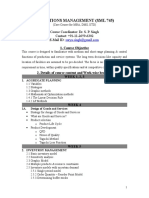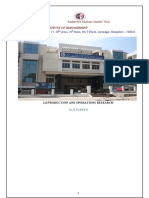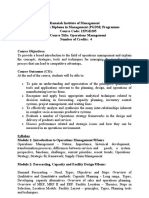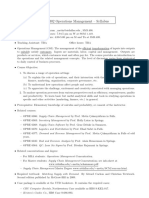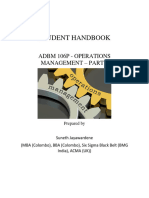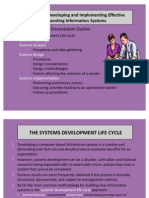0 ratings0% found this document useful (0 votes)
4 viewsOperations Management_ Course Outline _2024
Uploaded by
fikuerrbailandoCopyright
© © All Rights Reserved
Available Formats
Download as PDF, TXT or read online on Scribd
0 ratings0% found this document useful (0 votes)
4 viewsOperations Management_ Course Outline _2024
Uploaded by
fikuerrbailandoCopyright
© © All Rights Reserved
Available Formats
Download as PDF, TXT or read online on Scribd
You are on page 1/ 6
SVKM’s NMIMS ASMSOC – Course Outline
Course Code 742QT0C009
Course Title Operations Management
Course Dr. Kajori Banerjee
Instructor/s Prof. Rajiv Wad
Prof. Anantha Murthy N K-VF
Dr. Sopnamayee Acharya
Dr. Vidyasagar Voorugonda
Course 4
Credit
Program and B.Com. (Hons.) Semester -VI
Semester
Pre-Requisite Basics of Business Practices
Learning Learning Objectives:
Objectives To acquire knowledge of concepts and application of operations
management in various functional areas of business (PLO 1a)
To analyse and interpret the data to evolve strategies for business. (PLO
2b)
To demonstrate effectively oral and written communication through a
project. (PLO 3a)
Learni A complete understanding about various functions and discipline of
ng
Operations Management and Incorporating various Japanese
Outco
mes techniques in day to day working to show conceptual clarity of the
business function.
Understanding of Operations Research and its application to
develop strategies for business.
Pedagogy Lectures; PPTs, Videos; Case Studies, Numericals
Course This course illustrates the concepts in operations management research and
Description discusses its application in business.
Evaluation
Pattern Specific % AOL Intended CLOs to be
Assessment Weightag Instrument Assessed
Methods / e (Marks) s CLO 1 CLO 2 CLO 3
Task
Class 30% Test yes yes no
assignment (15
marks)
Mid-term 40% Case study/ yes yes no
(20 conceptual
marks)
Project 30% Presentation yes yes yes
(15
marks)
Total (ICA) 50 (50%)
TEE 50 (50%) yes yes yes
Course Session Plan
Session Topics / Module Chapters (Mention Page Numbers)
/ Articles / Cases / Material
and Activities
Introduction to Operations Management RB Khanna
1-4 1. Basics of operations management Russell & Taylor
2. Scope & functions
3. Production Vs Productivity
4. Partial and Total Productivity
5. 4 Ms
6. Efficiency Vs Effectiveness
CLO 1
(Numericals included)
5-8 Production Systems RB Khanna
1. Continuous: Mass / Russell & Taylor
Flowline production
2. Batch Production
3. Job production
4. Projects
CLO 1
(Numericals included)
9 – 10 Plant Location RB Khanna
1. Factors affecting plant location Russell & Taylor
2. Rural Vs Urban Factors
CLO 1
(Numericals included)
11-16 Plant Layout RB Khanna
1. Principles of plant Layout / Russell & Taylor
Factors affecting plant layout
2. Material flow system (I type,
U type, S Type, O Type, L
Type)
3. Process Charts (Operations &
Flow Type)
4. Type of Plant Layouts
(Process, Product, Fixed
Position, Hybrid)
CLO 1
(Numericals included)
17- 21 Inventory Management RB Khanna
1. Concept of EOQ (Finding EOQ, Russell & Taylor
Total Cost, No. of Orders,
Cycle Time)
2. ABC Analysis
3. VED Analysis
4. FSN Analysis
5. SOS and GOLF Analysis
CLO 1
(Numericals included)
22 - 23 Maintenance Management RB Khanna
1. Preventive and SN Chary
Breakdown maintenance
2. Maintenance Curve
3. Planned Maintenance
CLO 1
(Numericals included)
24 - 29 Various techniques: RB Khanna
1. Kaizen Russell &
2. Kanban Taylor SN
3. JIDOKA, POKA YOKE, Chary
5S, GEMBA, ANDON
4. Six Sigma
5. Quality Control
6. 7 Quality Tools
CLO 3
30 Basics of ISO RB Khanna
CLO 3 Russell & Taylor
31-40 Network Analysis – CPM& PERT N.D. Vohra
Critical Path Method
1. Introduction.
2. Basic concepts
3. Construction of simple network,
dummy included
4. Time Estimates in CPM: Earliest
Start Time (ET) and Earliest Finish
Time (EF), Latest Start Time (LS)
Latest Finish Time (LF)
5. Float of an Activity: Total Float,
Interfering Float, Free Float and
Independent Float.
6. Concept of Critical events, critical
activities, critical path.
Time-cost Trade-Off - Crashing
Optimum cost and minimum
time problems.
Note: Max 10 to 15 activities in a
network
Cost Slope.
Stepwise crashing to be done.
Optimum cost and minimum
time problems.
Crashing answer should be
obtained within a maximum of 6
(six) steps. Max. 12 activities.
PERT
1. Three Time Estimates
2. Expected project duration,
Expected Activity durations and
Variance of activities
3. Estimate of Probability. 90%, 95%,
99% assurance period.
4. Reading of normal tables. Given
various durations, find probability
of completion.
Distinction between PERT and CPM.
CLO 2
(Numericals included)
41 - 45 Linear Programming – I [Graphical] N.D. Vohra
1. Formulation and solving of
Linear Programming Problems.
2. Minimization and
Maximization types.
3. Mixed constraints.
4. Explanation of infeasible
and unbounded solutions
CLO 2
(Numericals included)
46 - 60 Linear Programming – II [Simplex] N.D. Vohra
1. Formulation and solving of linear
programming model for the
given data. Maximization (all
constraints of the type ≤ only) and
minimization (all constraints of
the type ≥ only) type of problems.
2. Mixed constraints only simple
problems.
3. Total number of inequations to be
upto at most three (3) and total
number of decision variables to be
upto at most 3. All solutions to
be completed within
2
iterations (excluding the initial
table).
4. Degeneracy, two minimum ratios
being equal, ‘infinity’ and
‘negative’
minimu
m ratios included.
5. Unbounded solutions to the initial
problem
6. Multiple optimal solution
7. Infeasible solution
CLO 2
(Numericals included)
Text Books:
Reading
List and 1. R.B. Khanna, Production and Operations Management (2015). PHI
References Learning.
2. R. Russell & B. W. Taylor, (8th edition, 2013). Operations Management –
Creating Value across the Supply Chain. Wiley India.
3. N D Vohra, (6th edition, 2021). Quantitative Techniques in Management .
McGraw Hill.
Reference Books:
1. Ram Naresh Roy. A. (2007). Modern Approach to
Operations Management. New Age International (P) Ltd.
2. SN Chary (2019). Production & Operations Management. Tata
McGraw- Hill Education (6th Edition)
3. Janat Shah (2016). Supply Chain Management-Text & Cases. Pearson India.
(2nd Edition)
4. Kapoor V. K. (2014) Operations Research. S. Chand & Sons Publications
Prepared by Faculty Approved by Program Approved by Associate
Members Chairperson Deans
Dr. Kajori Banerjee
Approved by I/C Dean –
ASM SOC
Annexure
Tentative ICA and TEE
Specific Assessment AOL
% Weightage (Marks)
Methods / Task Instruments Tentative dates
Class assignment 30% (15 marks) Test April, 2024
Case study/
Mid-term 40% (20 marks)
numerical 14/3/24 to 16/3/24
Rubric-based
Project 30% (15 marks)
group activity Jan-March, 2024
Total (ICA) 50 (50%)
TEE 50 (50%) 6/5/24-14/5/24
You might also like
- Production & Operations Management - BUAD 802No ratings yetProduction & Operations Management - BUAD 802139 pages
- OM Course Outline 2023-24 (Sections A & B)No ratings yetOM Course Outline 2023-24 (Sections A & B)4 pages
- BS OM LSCM 7001 Semester I 2019 - 21 July 2019 Course PLAN StudentNo ratings yetBS OM LSCM 7001 Semester I 2019 - 21 July 2019 Course PLAN Student6 pages
- CO-Gen-Operations - Management - 2021-22 CNo ratings yetCO-Gen-Operations - Management - 2021-22 C10 pages
- Course Outline Operations Management a+B+CNo ratings yetCourse Outline Operations Management a+B+C13 pages
- Independent University, Bangladesh School of Business MBA Program Course OutlineNo ratings yetIndependent University, Bangladesh School of Business MBA Program Course Outline6 pages
- Production & Operations Management: Faculty: Prof. Rajeev ANo ratings yetProduction & Operations Management: Faculty: Prof. Rajeev A5 pages
- Sem III_SYBCOM_Operations Management_24_25No ratings yetSem III_SYBCOM_Operations Management_24_254 pages
- Course Outline - Intro. To Operations MGMT - FMG 27, IMG 12 & FM 1-Prof. Vinaytosh Mishra and Prof. Kaustav KunduNo ratings yetCourse Outline - Intro. To Operations MGMT - FMG 27, IMG 12 & FM 1-Prof. Vinaytosh Mishra and Prof. Kaustav Kundu4 pages
- Course Outline: Operations Management 1-A Course Code: Credit:1.5, Area: Program: PGDM Term Academic YearNo ratings yetCourse Outline: Operations Management 1-A Course Code: Credit:1.5, Area: Program: PGDM Term Academic Year5 pages
- UT Dallas Syllabus For Opre6302.502.10s Taught by Metin Cakanyildirim (Metin)No ratings yetUT Dallas Syllabus For Opre6302.502.10s Taught by Metin Cakanyildirim (Metin)4 pages
- Part 1 - Student Handbook - ADBM 106 - MAnaging OperationsNo ratings yetPart 1 - Student Handbook - ADBM 106 - MAnaging Operations52 pages
- BA7201 - Operations Management - SyllabusNo ratings yetBA7201 - Operations Management - Syllabus1 page
- Operations & Supply Chain Management-TYBBANo ratings yetOperations & Supply Chain Management-TYBBA6 pages
- Download Study Resources for Contemporary Project Management 2nd Edition Kloppenborg Test Bank100% (8)Download Study Resources for Contemporary Project Management 2nd Edition Kloppenborg Test Bank46 pages
- Materi Minggu 5 - Developing Project Plan - Coret2No ratings yetMateri Minggu 5 - Developing Project Plan - Coret235 pages
- Maasai Mara University: This Study Resource WasNo ratings yetMaasai Mara University: This Study Resource Was4 pages
- Project Title: Proposed Waiting Shed Location: Brgy. Lumbia, Cagayab de Oro City Owner: Lgu-Brgy. Lumbia, Cdoc100% (3)Project Title: Proposed Waiting Shed Location: Brgy. Lumbia, Cagayab de Oro City Owner: Lgu-Brgy. Lumbia, Cdoc2 pages
- Project Proposal: COMSATS University Islamabad, Park Road, Chak Shahzad, Islamabad PakistanNo ratings yetProject Proposal: COMSATS University Islamabad, Park Road, Chak Shahzad, Islamabad Pakistan22 pages
- Quantitative Techniques For Business DecisionsNo ratings yetQuantitative Techniques For Business Decisions8 pages
- Aace International Scheduling: Critical Path Method (CPM)No ratings yetAace International Scheduling: Critical Path Method (CPM)1 page
- Btech Oe 7 Sem Operations Research Koe075 2023No ratings yetBtech Oe 7 Sem Operations Research Koe075 20233 pages
- CH10 Developing and Implementing Effective AISNo ratings yetCH10 Developing and Implementing Effective AIS27 pages
- BS OM LSCM 7001 Semester I 2019 - 21 July 2019 Course PLAN StudentBS OM LSCM 7001 Semester I 2019 - 21 July 2019 Course PLAN Student
- Independent University, Bangladesh School of Business MBA Program Course OutlineIndependent University, Bangladesh School of Business MBA Program Course Outline
- Production & Operations Management: Faculty: Prof. Rajeev AProduction & Operations Management: Faculty: Prof. Rajeev A
- Course Outline - Intro. To Operations MGMT - FMG 27, IMG 12 & FM 1-Prof. Vinaytosh Mishra and Prof. Kaustav KunduCourse Outline - Intro. To Operations MGMT - FMG 27, IMG 12 & FM 1-Prof. Vinaytosh Mishra and Prof. Kaustav Kundu
- Course Outline: Operations Management 1-A Course Code: Credit:1.5, Area: Program: PGDM Term Academic YearCourse Outline: Operations Management 1-A Course Code: Credit:1.5, Area: Program: PGDM Term Academic Year
- UT Dallas Syllabus For Opre6302.502.10s Taught by Metin Cakanyildirim (Metin)UT Dallas Syllabus For Opre6302.502.10s Taught by Metin Cakanyildirim (Metin)
- Part 1 - Student Handbook - ADBM 106 - MAnaging OperationsPart 1 - Student Handbook - ADBM 106 - MAnaging Operations
- EDF Data Visualization Professional CoursewareFrom EverandEDF Data Visualization Professional Courseware
- Download Study Resources for Contemporary Project Management 2nd Edition Kloppenborg Test BankDownload Study Resources for Contemporary Project Management 2nd Edition Kloppenborg Test Bank
- Materi Minggu 5 - Developing Project Plan - Coret2Materi Minggu 5 - Developing Project Plan - Coret2
- Project Title: Proposed Waiting Shed Location: Brgy. Lumbia, Cagayab de Oro City Owner: Lgu-Brgy. Lumbia, CdocProject Title: Proposed Waiting Shed Location: Brgy. Lumbia, Cagayab de Oro City Owner: Lgu-Brgy. Lumbia, Cdoc
- Project Proposal: COMSATS University Islamabad, Park Road, Chak Shahzad, Islamabad PakistanProject Proposal: COMSATS University Islamabad, Park Road, Chak Shahzad, Islamabad Pakistan
- Aace International Scheduling: Critical Path Method (CPM)Aace International Scheduling: Critical Path Method (CPM)








